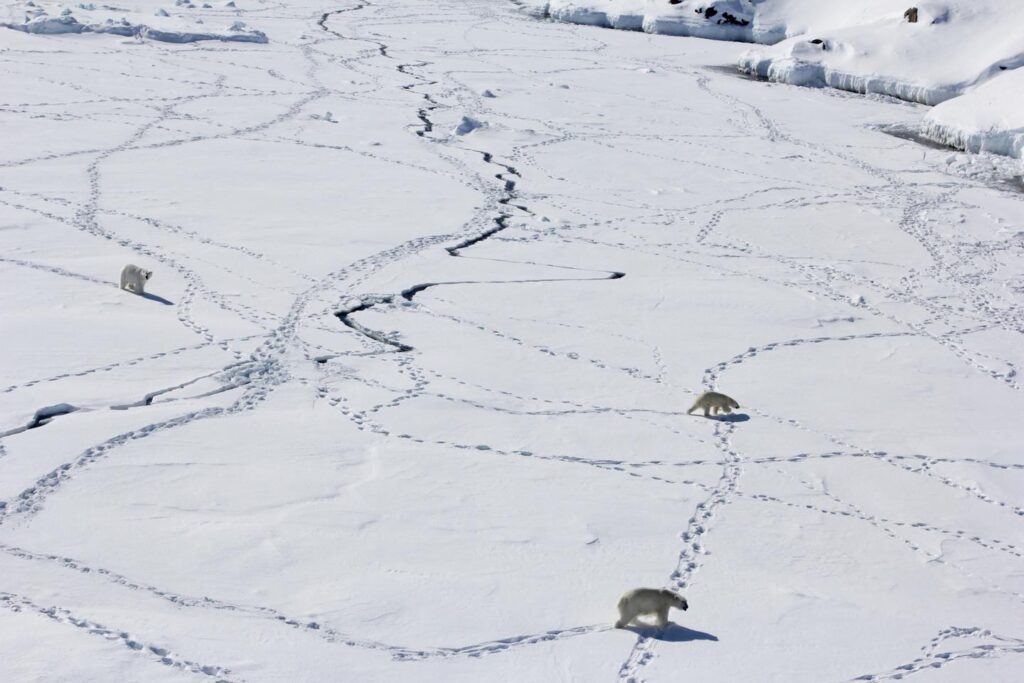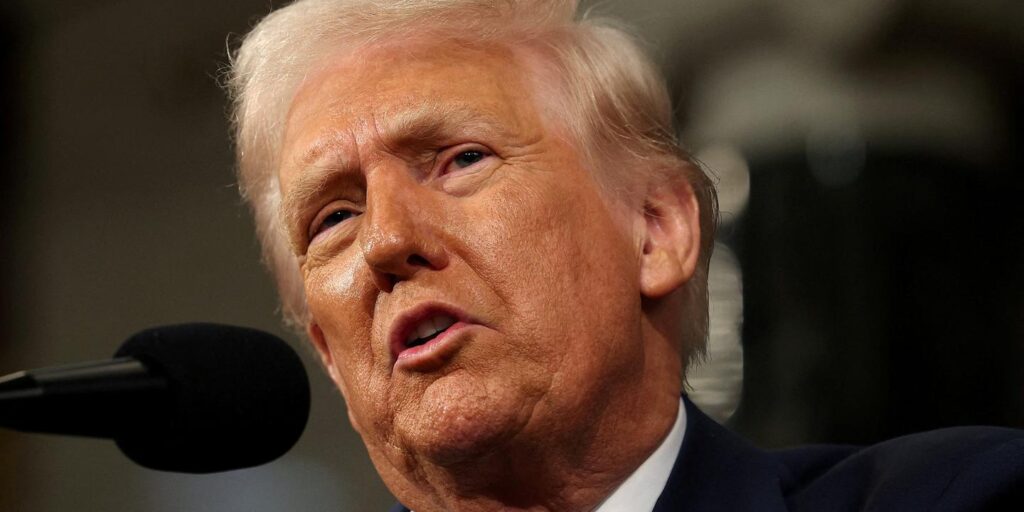The United States has sought to formally position itself as Europe’s biggest seller of protection and energy security following a $750bn trade deal on Sunday.
The deal, clinched by US President Donald Trump and European Commission chief Ursula von der Leyen at Trump’s Turnberry golf resort in Scotland, imposes a 15 percent tariff on European pharmaceutical, automobile and semiconductor exports to the US, to balance a European trade surplus, von der Leyen said.
Tariffs of 50 percent, which Trump previously imposed on European aluminium and steel, will also remain, while the European Union will not impose any reciprocal tariffs.
The bloc also committed to spending $250bn a year on US energy exports over and above present levels until 2027, and “hundreds of billions of dollars” on US weapons.
The deputy chairman of Russia’s National Security Council, Dmitry Medvedev, called the deal “anti-Russian” since it appeared to seize what was, before the Ukraine war, Russia’s biggest energy market.
The next day, Trump shortened a 50-day deadline he had issued to Russian President Vladimir Putin on July 14 to reach a ceasefire in Ukraine.
“I’m going to make a new deadline of about … 10 or 12 days from today,” Trump told reporters, pulling the deadline back from September 2 to about August 9.
A third round of talks between Russia and Ukraine last week produced no ceasefire, only another exchange of prisoners of war.
For the first time, Ukrainian President Volodymyr Zelenskyy instructed his negotiators to seek the return of Ukrainian children Russia has abducted from occupied territories since the start of the war. Kremlin newswire TASS reported that civilians would also be exchanged, without elaborating.
Weapons for Ukraine
Although Trump has not said what he will do when his deadline for a ceasefire agreement expires, it represents an about-turn on his position in February, when he considered Ukraine the main obstacle to peace.
“President Zelenskyy is not ready for peace if America is involved,” he wrote then on his Truth Social account, “because he feels our involvement gives him a big advantage in negotiations.”
Zelenskyy welcomed the shorter deadline, calling it “an extremely significant statement”.
“Every night there are strikes, constant Russian attempts to hurt Ukraine,” Zelenskyy said.
Russia has pounded Ukraine’s cities with combined drone and missile strikes every night for the past week. Ukraine shot down or electronically suppressed 791 out of 891 drones Russia launched between July 23 and 29, almost 90 percent, but fewer than half the missiles – just 20 out of 42.
That difference in ratio underscores Ukraine’s difficulty in intercepting ballistic missiles, against which only US-made Patriot interceptor missiles are effective.
Ukraine’s European allies have been signing onto a framework agreement reached this month between the US and Germany, whereby allies donating Patriot systems to Ukraine are given priority placement in purchasing new ones.
Lithuania said it was ready to help supply $35m in Patriot systems to Ukraine, following Germany, Norway, Denmark and Sweden. Germany’s defence minister, Boris Pistorius, said three Patriot batteries had been sent to Ukraine. In April, Zelenskyy said he was seeking 10 batteries.
Zelenskyy said he had signed $72m in new state contracts for interceptor drones last week, which are among its most effective weapons against Russia’s kamikaze and spy drones.
“A plan has been approved to reach the amount of 500 to 1,000 interceptors (drones) per day,” he said.
The US also approved foreign military sales of Bradley Fighting Vehicles and Hawk air defence systems to Ukraine on Thursday.

Russia makes gains as Zelenskyy faces protests
Russia appeared unfazed by these moves, driving onwards to seize a series of Ukrainian villages during the week, with the worst fighting happening around Pokrovsk, in Ukraine’s east.
The Russian Ministry of Defence said its troops had captured Varachino in Sumy on July 23, and probably seized Novoekonomichne in Donetsk, northeast of Pokrovsk, on Friday.
Zeleni Gai fell on Saturday, and Boykovka and Belgiyka on Monday, all in Donetsk. On Tuesday, Russia seized Novoukrainka and Temirovka in Zaporizhia. A Russian military expert told TASS that it now had control of a 5km section of border with Russia.
Zelenskyy faced his first wartime protests during the past week, after stripping the country’s top anti-corruption authorities of their independence.
The move followed an attempt by the National Anti-Corruption Bureau of Ukraine (NABU) and the Specialized Anti-Corruption Prosecutor’s Office (SAPO) to indict members of the State Security Service (SBU) for corruption.
Zelenskyy saw this as a Russian attempt to undermine one of Ukraine’s most effective military services.
The SBU has launched a series of successful long-range strikes inside Russia, targeting energy infrastructure and weapons factories.
Perhaps its most famous operation was Operation Spiderweb, which destroyed dozens of Russian long-range bombers on the ground in June.
However, Zelenskyy’s move offended not only Ukrainians, who protested. The EU temporarily froze 1.7 billion euros in aid to Ukraine, and von der Leyen advised Zelenskyy to “preserve independent anti-corruption bodies, which are cornerstones of Ukraine’s rule of law”.
On July 24, Zelenskyy said he had signed new legislation that would “ensure the strength of the rule of law system, and there will be no Russian influence or interference in the activities of law enforcement”.
NABU and SAPO were involved in drafting the new bill, and the EU backed it. “We welcome the Ukrainian government’s decision to act,” said a spokesperson for Brussels.
On Sunday, Zelenskyy said he had increased the SBU’s funding. Its personnel limit was raised from 31,000 to 41,000, with up to a quarter of that number in its Special Operations Centre.
SBU operations appeared to have continued unabated.


Ukraine’s drones intercepted
Russia said it shot down 105 Ukrainian drones overnight on Friday. The drones appeared to have targeted railway power lines and regional airports, and succeeded in causing rail service delays and temporary airport shutdowns in southwest Russia and the Caucasus – Vladikavkaz, Grozny, Magas, Mineralnye Vody, Nalchik, Stavropol, Sochi and Tambov.
The governor of the Leningrad region said at least 10 Ukrainian drones were downed near the city on Sunday. Pulkovo airport was closed during the attack, and the city’s annual Navy Day parade was cancelled, but a navy drill went ahead, watched by Putin on television.
On Monday, pro-Ukrainian hackers disabled the computers of Aeroflot, the state airline, grounding more than 50 round-trip flights and bringing Moscow’s Sheremetyevo airport to a standstill.


